Growing Old in America: Expectations vs. Reality – Pew Research Center
Learn our analysis on: Immigration & Migration | Podcasts | Election 2024
Learn our analysis on: Immigration & Migration | Podcasts | Election 2024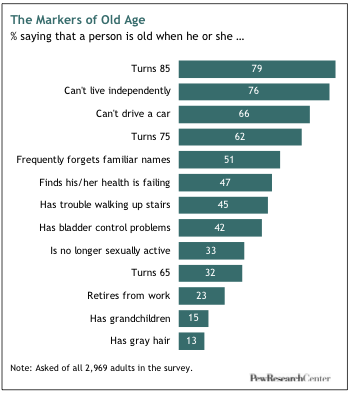 Getting previous isn’t practically as dangerous as folks assume will probably be. Neither is it fairly nearly as good.
Getting previous isn’t practically as dangerous as folks assume will probably be. Neither is it fairly nearly as good.
On facets of on a regular basis life starting from psychological acuity to bodily dexterity to sexual exercise to monetary safety, a brand new Pew Analysis Middle Social & Demographic Developments survey on growing old amongst a nationally consultant pattern of two,969 adults finds a large hole between the expectations that younger and middle-aged adults have about previous age and the precise experiences reported by older Individuals themselves.
These disparities come into sharpest focus when survey respondents are requested a couple of sequence of unfavourable benchmarks usually related to growing old, akin to sickness, reminiscence loss, an incapacity to drive, an finish to sexual exercise, a battle with loneliness and melancholy, and issue paying payments. In each occasion, older adults report experiencing them at decrease ranges (usually far decrease) than youthful adults report anticipating to come across them after they develop previous.1
On the identical time, nevertheless, older adults report experiencing fewer of the advantages of growing old that youthful adults count on to take pleasure in after they develop previous, akin to spending extra time with their household, touring extra for pleasure, having extra time for hobbies, doing volunteer work or beginning a second profession.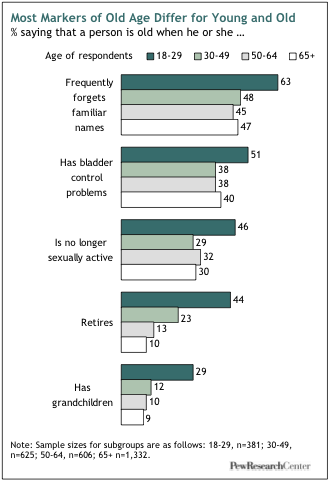 These era gaps in notion additionally prolong to probably the most fundamental query of all about previous age: When does it start? Survey respondents ages 18 to 29 consider that the typical particular person turns into previous at age 60. Center-aged respondents put the edge nearer to 70, and respondents ages 65 and above say that the typical particular person doesn’t grow to be previous till turning 74.
These era gaps in notion additionally prolong to probably the most fundamental query of all about previous age: When does it start? Survey respondents ages 18 to 29 consider that the typical particular person turns into previous at age 60. Center-aged respondents put the edge nearer to 70, and respondents ages 65 and above say that the typical particular person doesn’t grow to be previous till turning 74.
Different potential markers of previous age–akin to forgetfulness, retirement, turning into sexually inactive, experiencing bladder management issues, getting grey hair, having grandchildren–are the themes of comparable perceptual gaps. For instance, practically two-thirds of adults ages 18 to 29 consider that when somebody “ceaselessly forgets acquainted names,” that particular person is previous. Lower than half of all adults ages 30 and older agree.
Nevertheless, a handful of potential markers–failing well being, an incapacity to reside independently, an incapacity to drive, issue with stairs–engender settlement throughout all generations concerning the diploma to which they function an indicator of previous age.
The survey findings would appear to verify the previous noticed that you just’re by no means too previous to really feel younger. In truth, it exhibits that the older folks get, the youthful they really feel–comparatively talking. Amongst 18 to 29 year-olds, about half say they really feel their age, whereas about quarter say they really feel older than their age and one other quarter say they really feel youthful. In contrast, amongst adults 65 and older, absolutely 60% say they really feel youthful than their age, in contrast with 32% who say they really feel precisely their age and simply 3% who say they really feel older than their age.
Furthermore, the hole in years between precise age and “felt age” widens as folks get older. Practically half of all survey respondents ages 50 and older say they really feel at the least 10 years youthful than their chronological age. Amongst respondents ages 65 to 74, a 3rd say they really feel 10 to 19 years youthful than their age, and one-in-six say they really feel at the least 20 years youthful than their precise age.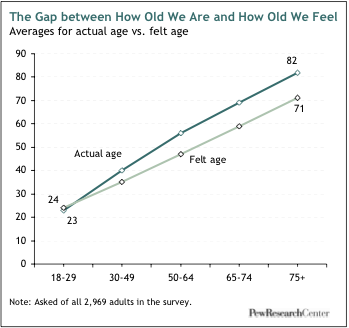 In sync with this upbeat manner of counting their felt age, older adults even have a count-my-blessings perspective when requested to look again over the total arc of their lives. Practically half (45%) of adults ages 75 and older say their life has turned out higher than they anticipated, whereas simply 5% say it has turned out worse (the rest say issues have turned out the way in which they anticipated or don’t have any opinion). All different age teams additionally tilt optimistic, however significantly much less so, when requested to evaluate their lives to date towards their very own expectations.
In sync with this upbeat manner of counting their felt age, older adults even have a count-my-blessings perspective when requested to look again over the total arc of their lives. Practically half (45%) of adults ages 75 and older say their life has turned out higher than they anticipated, whereas simply 5% say it has turned out worse (the rest say issues have turned out the way in which they anticipated or don’t have any opinion). All different age teams additionally tilt optimistic, however significantly much less so, when requested to evaluate their lives to date towards their very own expectations.
To make certain, there are burdens that include previous age. About one-in-four adults ages 65 and older report experiencing reminiscence loss. About one-in-five say they’ve a critical sickness, will not be sexually energetic, or usually really feel unhappy or depressed. About one-in-six report they’re lonely or have hassle paying payments. One-in-seven can not drive. One-in-ten say they really feel they aren’t wanted or are a burden to others.
However in relation to these and different potential issues associated to previous age, the share of youthful and middle-aged adults who report anticipating to come across them is far increased than the share of older adults who report truly experiencing them.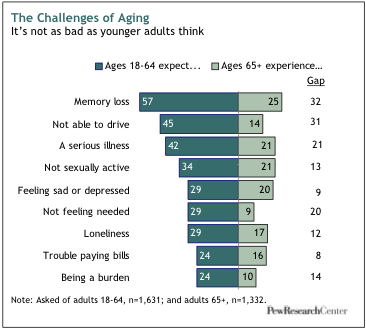 Furthermore, these issues will not be equally shared by all teams of older adults. These with low incomes are extra doubtless than these with excessive incomes to face these challenges. The one exception to this sample has to do with sexual inactivity; the chance of older adults reporting an issue on this realm of life will not be correlated with revenue.
Furthermore, these issues will not be equally shared by all teams of older adults. These with low incomes are extra doubtless than these with excessive incomes to face these challenges. The one exception to this sample has to do with sexual inactivity; the chance of older adults reporting an issue on this realm of life will not be correlated with revenue.
Not surprisingly, troubles related to growing old speed up as adults advance into their 80s and past. For instance, about four-in-ten respondents (41%) ages 85 and older say they’re experiencing some reminiscence loss, in contrast with 27% of these ages 75-84 and 20% of these ages 65-74. Equally, 30% of these ages 85 and older say they usually really feel unhappy or depressed, in contrast with lower than 20% of those that are 65-84. And 1 / 4 of adults ages 85 and older say they not drive, in contrast with 17% of these ages 75-84 and 10% of those that are 65-74.
However even within the face of those challenges, the overwhelming majority of the “previous previous” in our survey seem to have made peace with their circumstances. Solely a miniscule share of adults ages 85 and older–1%–say their lives have turned out worse than they anticipated. It little doubt helps that adults of their late 80s are as doubtless as these of their 60s and 70s to say that they’re experiencing lots of the good issues related to growing old–be it time with household, much less stress, extra respect or extra monetary safety.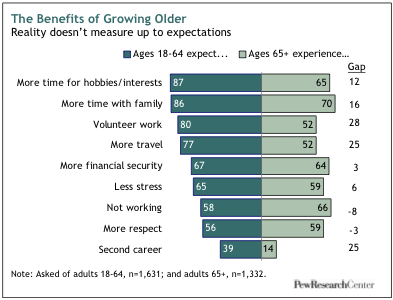 When requested about a variety of potential advantages of previous age, seven-in-ten respondents ages 65 and older say they’re having fun with extra time with their household. About two-thirds cite extra time for hobbies, extra monetary safety and never having to work. About six-in-ten say they get extra respect and really feel much less stress than after they have been youthful. Simply over half cite extra time to journey and to do volunteer work. Because the close by chart illustrates, older adults might not be experiencing these “upsides” at fairly the prevalence ranges that almost all youthful adults count on to take pleasure in them as soon as they develop previous, however their responses nonetheless point out that the phrase “golden years” is one thing greater than a syrupy greeting card sentiment.
When requested about a variety of potential advantages of previous age, seven-in-ten respondents ages 65 and older say they’re having fun with extra time with their household. About two-thirds cite extra time for hobbies, extra monetary safety and never having to work. About six-in-ten say they get extra respect and really feel much less stress than after they have been youthful. Simply over half cite extra time to journey and to do volunteer work. Because the close by chart illustrates, older adults might not be experiencing these “upsides” at fairly the prevalence ranges that almost all youthful adults count on to take pleasure in them as soon as they develop previous, however their responses nonetheless point out that the phrase “golden years” is one thing greater than a syrupy greeting card sentiment.
Of all the nice issues about getting previous, one of the best by far, in accordance with older adults, is having the ability to spend extra time with members of the family. In response to an open-ended query, 28% of these ages 65 and older say that what they worth most about being older is the prospect to spend extra time with household, and an extra 25% say that above all, they worth time with their grandchildren. A distant third on this listing is having extra monetary safety, which was cited by 14% of older adults as what they worth most about getting older.
These survey findings come at a time when older adults account for file shares of the populations of the US and most developed international locations. Some 39 million Individuals, or 13% of the U.S. inhabitants, are 65 and older–up from 4% in 1900. The century-long enlargement within the share of the world’s inhabitants that’s 65 and older is the product of dramatic advances in medical science and public well being in addition to steep declines in fertility charges. On this nation, the rise has leveled off since 1990, however it is going to begin rising once more when the primary wave of the nation’s 76 million child boomers flip 65 in 2011. By 2050, in accordance with Pew Analysis projections, about one-in-five Individuals can be over age 65, and about 5% can be ages 85 and older, up from 2% now. These ratios will put the U.S. at mid-century roughly the place Japan, Italy and Germany–the three “oldest” giant international locations on the earth–are at this time.
Any survey that focuses on older adults confronts one apparent methodological problem: A small however not insignificant share of individuals 65 and older are both too sick or incapacitated to participate in a 20-minute phone survey, or they reside in an institutional setting akin to a nursing residence the place they can’t be contacted.2
We assume that the older adults we have been unable to achieve for these causes have a decrease high quality of life, on common, than these we did attain. To mitigate this downside, the survey included interviews with greater than 800 adults whose dad and mom are ages 65 or older. We requested these grownup youngsters lots of the identical questions on their dad and mom’ lives that we requested of older adults about their very own lives. These “surrogate” respondents present a window on the experiences of the total inhabitants of older adults, together with these we couldn’t attain instantly. Not surprisingly, the portrait of previous age they draw is considerably extra unfavourable than the one painted by older grownup respondents themselves. We current a abstract of those second-hand observations on the finish of Part I within the perception that the 2 views complement each other and add texture to our report.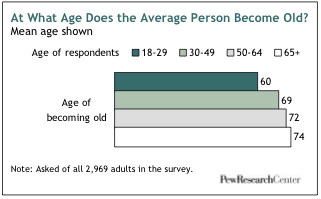 The Era Hole, Circa 2009. In a 1969 Gallup Ballot, 74% of respondents stated there was a era hole, with the phrase outlined within the survey query as “a significant distinction within the viewpoint of youthful folks and older folks at this time.” When the identical query was requested a decade later, in 1979, by CBS and The New York Instances, simply 60% perceived a era hole. However in maybe the one most intriguing discovering on this new Pew Analysis survey, the share that say there’s a era hole has spiked to 79%–even if there have been few overt generational conflicts in latest occasions of the type that roiled the Sixties. It could possibly be that the phrase now means one thing completely different, and fewer confrontational, than it did on the peak of the counterculture’s defiant challenges to the institution 40 years in the past. Regardless of the present understanding of the time period “era hole,” roughly equal shares of younger, middle-aged and older respondents within the new survey agree that such a spot exists. The most typical rationalization supplied by respondents of all ages has to do with variations in morality, values and work ethic. Comparatively few cite variations in political outlook or in makes use of of expertise.
The Era Hole, Circa 2009. In a 1969 Gallup Ballot, 74% of respondents stated there was a era hole, with the phrase outlined within the survey query as “a significant distinction within the viewpoint of youthful folks and older folks at this time.” When the identical query was requested a decade later, in 1979, by CBS and The New York Instances, simply 60% perceived a era hole. However in maybe the one most intriguing discovering on this new Pew Analysis survey, the share that say there’s a era hole has spiked to 79%–even if there have been few overt generational conflicts in latest occasions of the type that roiled the Sixties. It could possibly be that the phrase now means one thing completely different, and fewer confrontational, than it did on the peak of the counterculture’s defiant challenges to the institution 40 years in the past. Regardless of the present understanding of the time period “era hole,” roughly equal shares of younger, middle-aged and older respondents within the new survey agree that such a spot exists. The most typical rationalization supplied by respondents of all ages has to do with variations in morality, values and work ethic. Comparatively few cite variations in political outlook or in makes use of of expertise.
When Does Outdated Age Start? At 68. That’s the typical of all solutions from the two,969 survey respondents. However as famous above, this common masks a large, age-driven variance in responses. Greater than half of adults below 30 say the typical particular person turns into previous even earlier than turning 60. Simply 6% of adults who’re 65 or older agree. Furthermore, gender in addition to age influences attitudes on this topic. Ladies, on common, say an individual turns into previous at age 70. Males, on common, put the quantity at 66. As well as, on all 10 of the non-chronological potential markers of previous age examined on this survey, males are extra inclined than ladies to say the marker is a proxy for previous age.
Are You Outdated? Definitely not! Public opinion within the mixture might decree that the typical particular person turns into previous at age 68, however you gained’t get too far making an attempt to persuade those that age that the edge applies to them. Amongst respondents ages 65-74, simply 21% say they really feel previous. Even amongst those that are 75 and older, simply 35% say they really feel previous.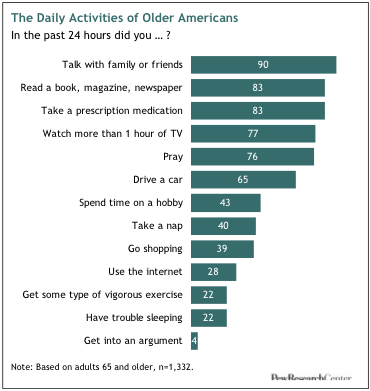 What Age Would You Wish to Stay To? The common response from our survey respondents is 89. One-in-five want to reside into their 90s, and eight% say they’d prefer to surpass the century mark. The general public’s verdict on probably the most fascinating life span seems to have ratcheted down a bit in recent times. A 2002 AARP survey discovered that the typical desired life span was 92.
What Age Would You Wish to Stay To? The common response from our survey respondents is 89. One-in-five want to reside into their 90s, and eight% say they’d prefer to surpass the century mark. The general public’s verdict on probably the most fascinating life span seems to have ratcheted down a bit in recent times. A 2002 AARP survey discovered that the typical desired life span was 92.
What Do Older Individuals Do Each Day? Amongst all adults ages 65 and older, nine-in-ten discuss with household or mates day-after-day. About eight-in-ten learn a guide, newspaper or journal, and the identical share takes a prescription drug day by day. Three-quarters watch greater than a hour of tv; about the identical share prays day by day. Practically two-thirds drive a automobile. Lower than half spend time on a pastime. About four-in-ten take a nap; about the identical share goes buying. Roughly one-in-four use the web, get vigorous train or have hassle sleeping. Simply 4% get into an argument with somebody. As adults transfer deeper into their 70s and 80s, day by day exercise ranges diminish on most fronts–particularly in relation to exercising and driving. However, day by day prayer and day by day medicine each improve with age.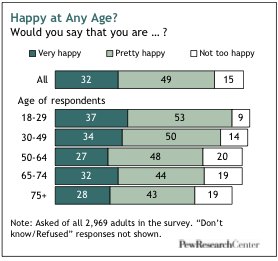 Are Older Adults Completely happy? They’re about as comfortable as everybody else. And maybe extra importantly, the identical components that predict happiness amongst youthful adults–good well being, good mates and monetary safety–by and huge predict happiness amongst older adults. Nevertheless, there are a couple of age-related variations in life’s happiness sweepstakes. Most notably, as soon as all different key demographic variables are held fixed, being married is a predictor of happiness amongst youthful adults however not amongst older adults (maybe as a result of a major share of the latter group is made up of widows or widowers, a lot of whom presumably have “banked” a number of the key marriage-related correlates of happiness, akin to monetary safety and a robust household life). Amongst all older adults, happiness varies little or no by age, gender or race.
Are Older Adults Completely happy? They’re about as comfortable as everybody else. And maybe extra importantly, the identical components that predict happiness amongst youthful adults–good well being, good mates and monetary safety–by and huge predict happiness amongst older adults. Nevertheless, there are a couple of age-related variations in life’s happiness sweepstakes. Most notably, as soon as all different key demographic variables are held fixed, being married is a predictor of happiness amongst youthful adults however not amongst older adults (maybe as a result of a major share of the latter group is made up of widows or widowers, a lot of whom presumably have “banked” a number of the key marriage-related correlates of happiness, akin to monetary safety and a robust household life). Amongst all older adults, happiness varies little or no by age, gender or race.
Retirement and Outdated Age. Retirement is a spot with out clear borders. Totally 83% of adults ages 65 and older describe themselves as retired, however the phrase means various things to completely different folks. Simply three-quarters of adults (76%) 65 and older match the traditional stereotype of the retiree who has fully left the working world behind.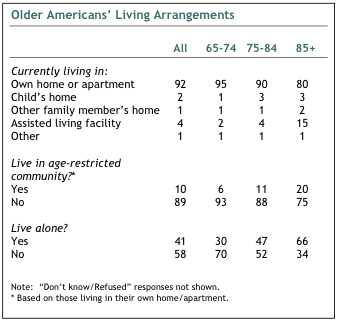 A further 8% say they’re retired however are working half time, whereas 2% say they’re retired however working full time and three% say they’re retired however in search of work. The remaining 11% of the 65-and-older inhabitants describe themselves as nonetheless within the labor drive, although not all of them have jobs. Regardless of the fuzziness round these definitions, one development is crystal clear from authorities knowledge3: After falling steadily for many years, the labor drive take part price of older adults started to development again upward about 10 years in the past. Within the Pew Analysis survey, the typical retiree is 75 years previous and retired at age 62.
A further 8% say they’re retired however are working half time, whereas 2% say they’re retired however working full time and three% say they’re retired however in search of work. The remaining 11% of the 65-and-older inhabitants describe themselves as nonetheless within the labor drive, although not all of them have jobs. Regardless of the fuzziness round these definitions, one development is crystal clear from authorities knowledge3: After falling steadily for many years, the labor drive take part price of older adults started to development again upward about 10 years in the past. Within the Pew Analysis survey, the typical retiree is 75 years previous and retired at age 62.
Residing Preparations. Greater than nine-in-ten respondents ages 65 and older reside in thei
r own residence or house, and the overwhelming majority are both very happy (67%) or considerably happy (21%) with their dwelling preparations. Nevertheless, many dwelling patterns change as adults advance into older age. For instance, simply 30% of adults ages 65-74 say they reside alone, in contrast with 66% of adults ages 85 and above. Additionally, simply 2% of adults ages 65-74 and 4% of adults ages 75-84 say they reside in an assisted dwelling facility, in contrast with 15% of these ages 85 and above.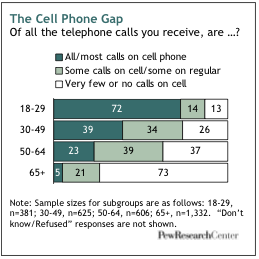 Outdated-Faculty Social Networking. The good majority of adults ages 65 and older (81%) say they’ve folks round them, aside from household, on whom they will depend on for social actions and companionship. About three-quarters say they’ve somebody they will discuss to after they have a private downside; six-in-ten say they’ve somebody they will flip to for assist with errands, appointments and different day by day actions. On the flip aspect of the coin, three-in-ten older adults say they “usually” assist out different older adults who’re in want of help, and an extra 35% say they generally do that. Most of those social connections stay intact as older adults proceed to age, however amongst these 85 and above, the share that say they usually or typically present help to others drops to 44%.
Outdated-Faculty Social Networking. The good majority of adults ages 65 and older (81%) say they’ve folks round them, aside from household, on whom they will depend on for social actions and companionship. About three-quarters say they’ve somebody they will discuss to after they have a private downside; six-in-ten say they’ve somebody they will flip to for assist with errands, appointments and different day by day actions. On the flip aspect of the coin, three-in-ten older adults say they “usually” assist out different older adults who’re in want of help, and an extra 35% say they generally do that. Most of those social connections stay intact as older adults proceed to age, however amongst these 85 and above, the share that say they usually or typically present help to others drops to 44%.
The Twitter Revolution Hasn’t Landed Right here. If there’s one realm of recent life the place young and old behave very in another way, it’s within the adoption of newfangled info applied sciences. Simply four-in-ten adults ages 65-74 use the web every day, and that share drops to simply one-in-six amongst adults 75 and above. In contrast, three-quarters of adults ages 18-30 go surfing day by day. The era hole is even wider in relation to cell telephones and textual content messages. Amongst adults 65 and older, simply 5% get most or all of their calls on a mobile phone, and simply 11% typically use their mobile phone to ship or obtain a textual content message. For adults below age 30, the comparable figures are 72% and 87%, respectively.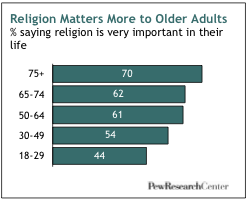 Faith and Outdated Age. Faith is a far larger a part of the lives of older adults than youthful adults. Two-thirds of adults ages 65 and older say faith is essential to them, in contrast with simply over half of these ages 30 to 49 and simply 44% of these ages 18 to 29. Furthermore, amongst adults ages 65 and above, a 3rd (34%) say faith has grown extra essential to them over the course of their lives, whereas simply 4% say it has grow to be much less essential and the bulk (60%) say it has stayed the identical. Amongst those that are over 65 and report having an sickness or feeling unhappy, the share who say that faith has grow to be extra essential to them rises to 43%.
Faith and Outdated Age. Faith is a far larger a part of the lives of older adults than youthful adults. Two-thirds of adults ages 65 and older say faith is essential to them, in contrast with simply over half of these ages 30 to 49 and simply 44% of these ages 18 to 29. Furthermore, amongst adults ages 65 and above, a 3rd (34%) say faith has grown extra essential to them over the course of their lives, whereas simply 4% say it has grow to be much less essential and the bulk (60%) say it has stayed the identical. Amongst those that are over 65 and report having an sickness or feeling unhappy, the share who say that faith has grow to be extra essential to them rises to 43%.
Staying in Contact with the Children. Practically nine-in-ten adults (87%) ages 65 and older have youngsters. Of this group, simply over half are involved with a son or daughter day-after-day, and an extra 40% are involved with at the least one little one–both in particular person, by cellphone or by e mail–at the least as soon as per week. Moms and daughters are in probably the most frequent contact; fathers and daughters the least. Sons fall within the center, and so they be in contact with older moms and dads at equal charges. General, three-quarters of adults who’ve a dad or mum or dad and mom ages 65 and older say they’re very happy with their relationship with their dad or mum(s), however that share falls to 62% if a dad or mum wants assist caring for his or her wants.
Was the Nice Bard Mistaken? Shakespeare wrote that the final of the “seven ages of man” is a second childhood. By means of the centuries, different poets and philosophers have noticed that oldsters and kids usually reverse roles as dad and mom get older. Not so, says the Pew Analysis survey. Simply 12% of oldsters ages 65 and older say they typically depend on their youngsters greater than their youngsters depend on them. A further 14% say their youngsters rely extra on them. The bulk–58%–says neither depends on the opposite, and 13% say they depend on each other equally. Responses to this query from youngsters of older dad and mom are broadly related.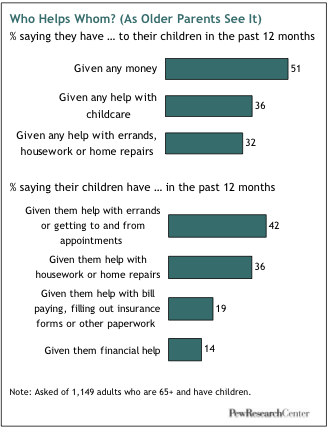 Intergenerational Transfers inside Households. Regardless of these reported patterns of non-reliance, older dad and mom and their grownup youngsters do assist one another out in quite a lot of methods. Nevertheless, the views on these transfers of time and money differ by era. For instance, about half (51%) of oldsters ages 65 and older say they’ve given their youngsters cash previously yr, whereas simply 14% say their youngsters have given them cash. The intra-family accounting comes out fairly in another way from the attitude of grownup youngsters. Amongst survey respondents who’ve a dad or mum or dad and mom ages 65 or older, 1 / 4 say they obtained cash from a dad or mum previously yr, whereas an virtually equal share (21%) say they gave cash to their dad or mum(s). There are related distinction in notion, by era, about who helps whom with errands and different day by day actions. (To be clear, the survey didn’t interview particular pairs of oldsters and kids; slightly, it contacted random samples who fell into these and different demographic classes.) Not surprisingly, as dad and mom advance deeper into previous age, each they and the grownup youngsters who’ve such dad and mom report that the steadiness of help tilts extra towards youngsters serving to dad and mom.
Intergenerational Transfers inside Households. Regardless of these reported patterns of non-reliance, older dad and mom and their grownup youngsters do assist one another out in quite a lot of methods. Nevertheless, the views on these transfers of time and money differ by era. For instance, about half (51%) of oldsters ages 65 and older say they’ve given their youngsters cash previously yr, whereas simply 14% say their youngsters have given them cash. The intra-family accounting comes out fairly in another way from the attitude of grownup youngsters. Amongst survey respondents who’ve a dad or mum or dad and mom ages 65 or older, 1 / 4 say they obtained cash from a dad or mum previously yr, whereas an virtually equal share (21%) say they gave cash to their dad or mum(s). There are related distinction in notion, by era, about who helps whom with errands and different day by day actions. (To be clear, the survey didn’t interview particular pairs of oldsters and kids; slightly, it contacted random samples who fell into these and different demographic classes.) Not surprisingly, as dad and mom advance deeper into previous age, each they and the grownup youngsters who’ve such dad and mom report that the steadiness of help tilts extra towards youngsters serving to dad and mom.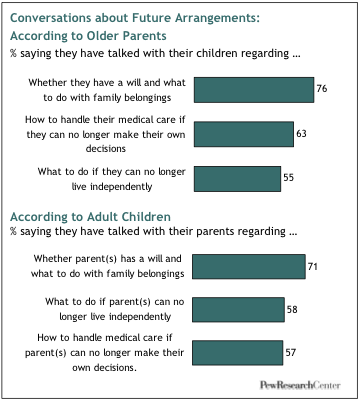 Conversations about Finish-of-Life Issues. Greater than three-quarters of adults ages 65 and older say they’ve talked with their youngsters about their wills; practically two-thirds say they’ve talked about what to do if they will not make their very own medical choices, and greater than half say they’ve talked with their youngsters about what to do if they will not reside independently. Related shares of grownup youngsters of older dad and mom report having had these conversations. Dad and mom and grownup youngsters agree that it’s the dad and mom who usually provoke these conversations, although 70% of older adults report that that is the case, in contrast with simply 52% of kids of older dad and mom who say the identical.
Conversations about Finish-of-Life Issues. Greater than three-quarters of adults ages 65 and older say they’ve talked with their youngsters about their wills; practically two-thirds say they’ve talked about what to do if they will not make their very own medical choices, and greater than half say they’ve talked with their youngsters about what to do if they will not reside independently. Related shares of grownup youngsters of older dad and mom report having had these conversations. Dad and mom and grownup youngsters agree that it’s the dad and mom who usually provoke these conversations, although 70% of older adults report that that is the case, in contrast with simply 52% of kids of older dad and mom who say the identical.
Outcomes for this report are from a phone survey carried out with a nationally consultant pattern of two,969 adults dwelling within the continental United States. A mixture of landline and mobile random digit dial (RDD) samples have been used to cowl all adults within the continental United States who’ve entry to both a landline or mobile phone. As well as, oversamples of adults 65 and older in addition to blacks and Hispa
nics have been obtained. The black and Hispanic oversamples have been achieved by oversampling landline exchanges with extra black and Hispanic residents in addition to callbacks to blacks and Hispanics interviewed in earlier surveys. A complete of two,417 interviews have been accomplished with respondents contacted by landline phone and 552 with these contacted on their cellular telephone. The info are weighted to provide a remaining pattern that’s consultant of the overall inhabitants of adults within the continental United States. Survey interviews have been carried out below the course of Princeton Survey Analysis Associates (PSRA).
With the help of PSRA, the Pew Analysis Middle carried out 4 focus teams earlier this yr in Baltimore, Md. Two teams have been made up of adults ages 65 and older; two others have been made up of adults with dad and mom ages 65 and older. Our goal was to take heed to abnormal Individuals discuss concerning the challenges and pleasures of rising previous, and the tales we heard throughout these focus teams helped us form our survey questionnaire. Focus group members have been advised that they could be quoted on this report, however we promised to not quote them by identify. The quotations interspersed all through these pages are drawn from these focus group conversations.
This report was edited and the overview written by Paul Taylor, government vice chairman of the Pew Analysis Middle and director of its Social & Demographic Trends project. Sections I, II and III have been written by Senior Researcher Kim Parker. Part IV was written by Analysis Affiliate Wendy Wang and Taylor. Part V was written by Senior Editor Richard Morin. The Demographics Part was written by Senior Author D’Vera Cohn and the info was compiled by Wang. Led by Ms. Parker, the total Social & Demographic Developments employees wrote the survey questionnaire and carried out the evaluation of its findings. The regression evaluation we used to look at the predictors of happiness amongst older and youthful adults was performed by a advisor, Cary L. Funk, affiliate professor within the Wilder Faculty of Authorities at Virginia Commonwealth College. The report was copy-edited by Marcia Kramer of Kramer Enhancing Companies. It was quantity checked by Pew Analysis Middle employees members Ana Gonzalez-Barrera, Daniel Dockterman and Cristina Mercado. We want to thank different PRC colleagues who supplied analysis and editorial steering, together with Andrew Kohut, Scott Keeter, Gretchen Livingston, Jeffrey Passel, Rakesh Kochhar and Richard Fry.
Learn the full report for extra particulars.
Signal as much as to obtain a month-to-month digest of the Middle’s newest analysis on the attitudes and behaviors of Individuals in key realms of day by day life
1615 L St. NW, Suite 800
Washington, DC 20036
USA
(+1) 202-419-4300 | Main
(+1) 202-857-8562 | Fax
(+1) 202-419-4372 | Media Inquiries
About Pew Research Center Pew Analysis Middle is a nonpartisan truth tank that informs the general public concerning the points, attitudes and traits shaping the world. It conducts public opinion polling, demographic analysis, media content material evaluation and different empirical social science analysis. Pew Analysis Middle doesn’t take coverage positions. It’s a subsidiary of The Pew Charitable Trusts.







